Blood Alley Blu-ray Movie
HomeBlood Alley Blu-ray Movie 
Warner Archive CollectionWarner Bros. | 1955 | 115 min | Not rated | Jul 18, 2017
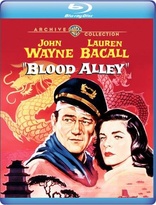
Movie rating
6.5 | / 10 |
Blu-ray rating
| Users | 0.0 | |
| Reviewer | 3.5 | |
| Overall | 3.5 |
Overview
Blood Alley (1955)
"Powder your nose, baby," the craggy-voiced skipper bellows. "We're coming into Hong Kong." Getting there wasn't easy for wily Merchant Marine Captain Tom Wilder. Wilder braves dangerous waters and pursues Red Chinese forces while steering a boatload of Chinese refugees and a doctor's daughter along a 300-mile waterway to freedom's shores.
Starring: John Wayne, Lauren Bacall, Paul Fix, Joy Kim, Berry KroegerDirector: William A. Wellman
| Adventure | Uncertain |
| Action | Uncertain |
Specifications
Video
Video codec: MPEG-4 AVC
Video resolution: 1080p
Aspect ratio: 2.55:1
Original aspect ratio: 2.55:1
Audio
English: DTS-HD Master Audio 2.0 (48kHz, 24-bit)
Subtitles
English SDH
Discs
Blu-ray Disc
Single disc (1 BD)
Playback
Region A (B, C untested)
Review
Rating summary
| Movie | 3.5 | |
| Video | 3.5 | |
| Audio | 4.0 | |
| Extras | 2.0 | |
| Overall | 3.5 |
Blood Alley Blu-ray Movie Review
Ferry to Freedom
Reviewed by Michael Reuben July 31, 2017John Wayne wasn't originally cast as the heroic sea captain of Blood Alley, but he stepped into the role after Robert Mitchum departed the project over differences with director William Wellman (The Public Enemy and Battleground). The Duke was an apt replacement, because the character suited his familiar persona. Of the two Wayne films issued on Blu-ray by the Warner Archive Collection this month, Blood Alley is by far the superior effort—the other is The Sea Chase—even though the film was coolly received upon its release in 1955. Initially dismissed as a formulaic adventure story, the film plays better today, when Hollywood seems to have lost the knack for applying that particular formula. Blood Alley's Cold War politics are as dated as its politically incorrect casting, but it's still a diverting entertainment, powered by Wayne's reliable presence and Wellman's inventive re-creation of the perilous shores of the Formosa Strait on the coast of Northern California.
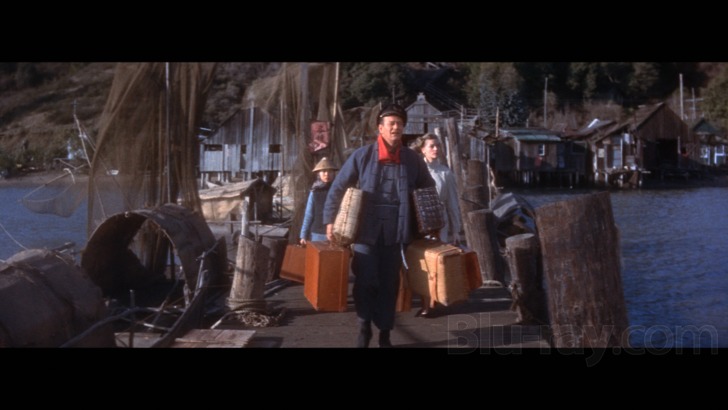
Wayne plays Tom Wilder, a captain in the American Merchant Marine, who is sprung from a Communist Chinese prison by a village of resourceful peasants wanting Wilder's help to reach Hong Kong, which was then still under British control. Led by the town elder, Mr. Tso (Paul Fix), and with the assistance of the aptly named Big Han (Mike Mazurki) and a U.S.-trained engineer known as Tack (Henry Nakamura), the town's population has conceived an intricate plan to steal a steamboat and evade the Red Chinese gunboats and destroyers—but they need Capt. Wilder's knowledge of the treacherous waters lying between them and freedom.
Blood Alley's script by Albert Sidney Fleischman (who adapted his novel) takes its time preparing for the voyage and introducing the characters, including the village's least likely inhabitant, an American physician's daughter named Cathy Grainger (Lauren Bacall), who is impatiently awaiting her father's return from treating a Red Chinese dignitary. Cathy and Wilder circle each other warily throughout the film, and although Wayne and Bacall don't display any special chemistry, Bacall is always interesting to watch. (They would be more effectively paired two decades later in The Shootist.) Besides, Cathy has trouble competing with the imaginary girlfriend that Wilder invented to help him survive prison, who is known only as "Baby" and with whom Wilder continues to converse throughout the film. (Wayne is sufficiently convincing in his conversations with thin air that you almost expect to see "Baby" in the credits.) Other colorful locals include Cathy's housekeeper, Susu (Joy Kim), and the imperious leader of the town's richest family, Old Feng (Berry Kroeger), whom the villagers suspect of secret efforts to undermine their escape. (They're right.)
Wellman stages the actual voyage with an effective combination of location photography and soundstage setups, and he gives Wilder and his makeshift crew plenty of obstacles to overcome, from enemy ships to fuel shortages to a raging storm. Wayne's casting was widely criticized at the time, probably because viewers were used to seeing him on horseback, but the Duke makes a convincing commander whether he's wearing spurs and driving cattle or donning a captain's hat and charting a course. At least here, unlike in The Sea Chase, he isn't burdened with the challenge of playing a different nationality. That handicap is imposed on supporting players like veteran character actor Fix, who was forced to don prosthetics to play the village elder Mr. Tso, or former wrestler Mazurki, who usually played thugs and gangsters like Moose Malloy in Murder, My Sweet, and who didn't even get the benefit of makeup in his unlikely role as a Chinese peasant.
Still, for sheer oddity, you can't beat Blood Alley's casting for Wei Ling, the demure wife of Mazurki's Big Han, who is played by Anita Ekberg, the Swedish—yes, Swedish—actress, best known today for her amorous turn in Fellini's La Dolce Vita. While Ekberg's name is prominently featured in the credits, she's easily overlooked, because her character has no lines. She just sits next to Big Han with a cap pulled down low over her bowed head, trying to blend in with the crowd of Asian-American extras and looking utterly lost.
Blood Alley Blu-ray Movie, Video Quality 

Like The Sea Chase, John Wayne's other
1955 release issued by the Warner Archive Collection,
Blood Alley was shot in Cinemascope by William H. Clothier, Wayne's favorite cinematographer
and the DP he chose to photograph The Alamo. Also like The Sea
Chase, Blood Alley presents
significant challenges in transferring and mastering. These films were made during a period of
major transition in filmmaking technology, when studios were experimenting with widescreen
formats to compete with TV, of which the anamorphic process dubbed Cinemascope was one
example. Studios were also attempting to develop in-house processing expertise to compete with
Technicolor, which is why the credits and trailer proudly announce that Blood Alley is presented
in "Warnercolor"—an inferior process that lasted only a few years before being abandoned.
Warnercolor is an obstacle to contemporary restoration efforts, because its color reproduction
was inferior and the process was uniquely subject to fading. Add to that the softening and spatial
distortions typical of Cinemascope lenses, plus the early stages of "yellow layer collapse" that
plagued Eastmancolor stock in the Fifties (see my discussion in connection with Silk Stockings),
and you have a daunting array of source limitations.
For this 1080p, AVC-encoded Blu-ray, the Warner Archive Collection commissioned a new
scan, which was performed by Warner's Motion Picture Imaging facility at 2K using a recently struck
interpositive. MPI then applied the latest in digital tools to restore the film's palette, followed by
WAC's customary meticulous cleaning and removal of dirt, scratches and similar flaws. The
resulting Blu-ray image is serviceable but somewhat disappointing, especially in comparison to
The Sea Chase. Blood Alley's image is noticeably grainier and less detailed, despite sharing with
The Sea Chase the same cameraman, photographic format, post-production process—and
nominally the same film stock. However, according to reliable sources, Kodak's tinkering with
its film chemistry had already commenced in the period between The Sea Chase, which was shot
first, and Blood Alley, so that the latter became one of the early victims of these ill-fated photo-chemical experiments. Even scenes in
the clearest daylight reveal a noticeably coarse grain
structure and a lack of sharpness, and the effect is accentuated by director Wellman's frequent
use of smoke and fog. The image looks better in motion than it does in screen captures, but early
signs of "yellow layer collapse" are unmistakable.
There is no faulting MPI's restoration of the film's color palette, which reproduces the many fine
shadings of earth tones with which Wellman and his creative team simulated a Chinese peasant
village both on soundstages and on location near the San Francisco Bay. Against this subtly
multicolored background, we get bright blue for the sky (when it's clear), occasional flashes of
red (whether from the Chinese Communist flag, Lauren Bacall's wardrobe or the Duke's
bandanna) and the delicate but ostentatious hues of Old Feng's eccentric wardrobe (see
screenshot 33). Black levels appear to be stable, contrast is adequate and the film's prominent
grain pattern hasn't been electronically stripped or reduced. WAC has mastered Blood Alley at its
usual high average bitrate, here 34.99 Mbps, with a capable encode.
In reviewing The Sea Chase, I noted the visual distortions introduced by Cinemascope's early
anamorphic lenses. Those artifacts are far less prevalent in Blood Alley, possibly because
Wellman made less use of camera pans than Sea Chase's director, John Farrow.
As with the video scoring of other films from this era, my score of 3.5 is meant to balance the
accuracy of the restoration efforts against the source's limitations.
Blood Alley Blu-ray Movie, Audio Quality 
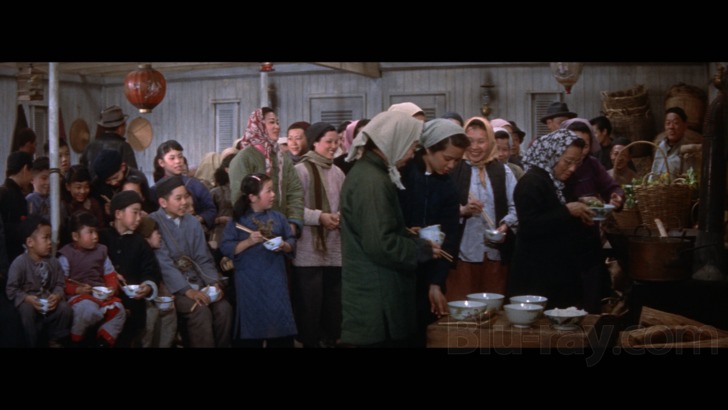
The audio report on Blood Alley is more favorable. Like The Sea Chase, it arrives on Blu-ray with a stereo track encoded in lossless DTS-HD MA 2.0 that is the product of Warner's Nineties effort to reclaim mixes for which the original elements were discarded. The film was originally released in both mono and four-track stereo, but Warner Brothers in the Fifites did not make a practice of retaining the original magnetic recordings of multi-track mixes. Forty years later, with a new appreciation for the value of preserving its library, the studio embarked on a project to capture and preserve two-channel mixes from the optical tracks of release prints. As a beneficiary of this effort, the Blu-ray soundtrack of Blood Alley reveals surprisingly robust stereo separation, of which the effect is most audible in the score by Roy Webb, the veteran composer of Bringing Up Baby and Out of the Past (and also The Sea Chase). The dialogue is clearly rendered, and the perilous voyage of the aging steamboat benefits from the track's enhanced fidelity and expanded dynamic range; the latter is especially crucial when a Chinese destroyer opens fire. Blood Alley may not sound like a recent release, but the audio is surprisingly effective for a film that's over sixty years old.
Blood Alley Blu-ray Movie, Special Features and Extras 
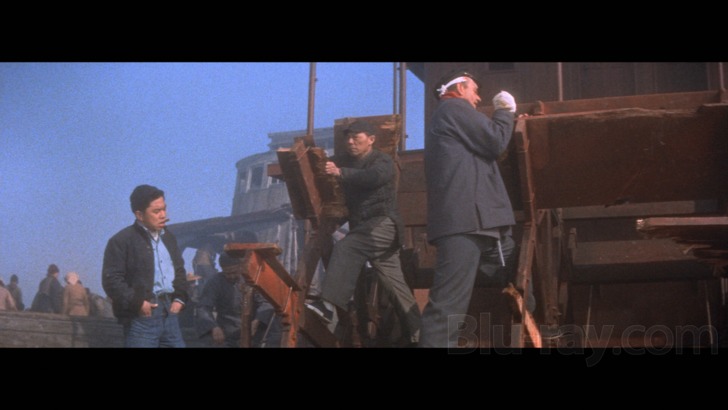
The extras have been ported over from Warner's 2005 DVD of Blood Alley. All of them have
been remastered in 1080p.
- Pathé Newsreel Footage (1080p; 1.37:1; 3:56): A selection of Fifties news clips featuring the Duke, including a visit to the set of Blood Alley. Gaps and periods of silence in the soundtrack reflect the condition of the source.
- 1955 Promo on Blood Alley (#1) (1080p; 1.78:1; 7:30): This is an excerpt from the Warner Bros. Presents TV series hosted by Gig Young. Before turning to a discussion of Blood Alley, Wayne describes his introduction to the movie industry.
- 1955 Promo on Blood Alley (#2) (1080p; 1.78:1; 7:40): In this second installment of Warner Bros. Presents, the Duke describes the technology of Cinemascope and narrates a tour of the film's locations in the San Francisco Bay area.
- Trailer (1080p; 2.55:1; 2:36): "Blood Alley . . . Where the Seas Run Red with Danger!"
Blood Alley Blu-ray Movie, Overall Score and Recommendation 
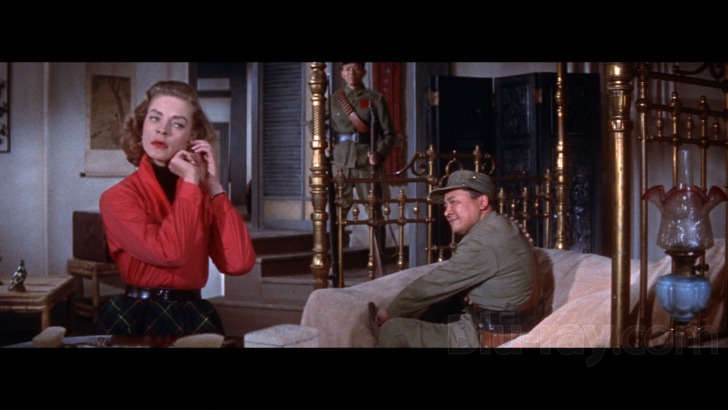
While Blood Alley is a superior entertainment to The Sea Chase, it remains a lesser effort in John
Wayne's filmography. WAC appears to have made the best of a problematic source, but as I have
previously noted, the company has set such a high
benchmark with its Blu-ray offerings that anything subpar stands out by comparison. Buyer's choice.
Similar titles
Similar titles you might also like

The Poseidon Adventure
1972

The High and the Mighty
1954

Fantastic Voyage
Fox Studio Classics
1966

Voyage to the Bottom of the Sea
Fox Studio Classics
1961

Captain Blood
1935

The Sea Hawk
Warner Archive Collection
1940

Hunter Killer 4K
2018

The World in His Arms
1952

Against All Flags
1952

Reap the Wild Wind
1942

Juggernaut
Reissue
1974

The Return of the Musketeers
1989

Advise & Consent
1962

The Professionals
1966

Buccaneer's Girl
1950

Legend of the Lost
1957

Shout at the Devil
Special Edition
1976

The Light at the Edge of the World
1971

Man in the Saddle
1951

Airwolf: The Complete Series
1984-1987